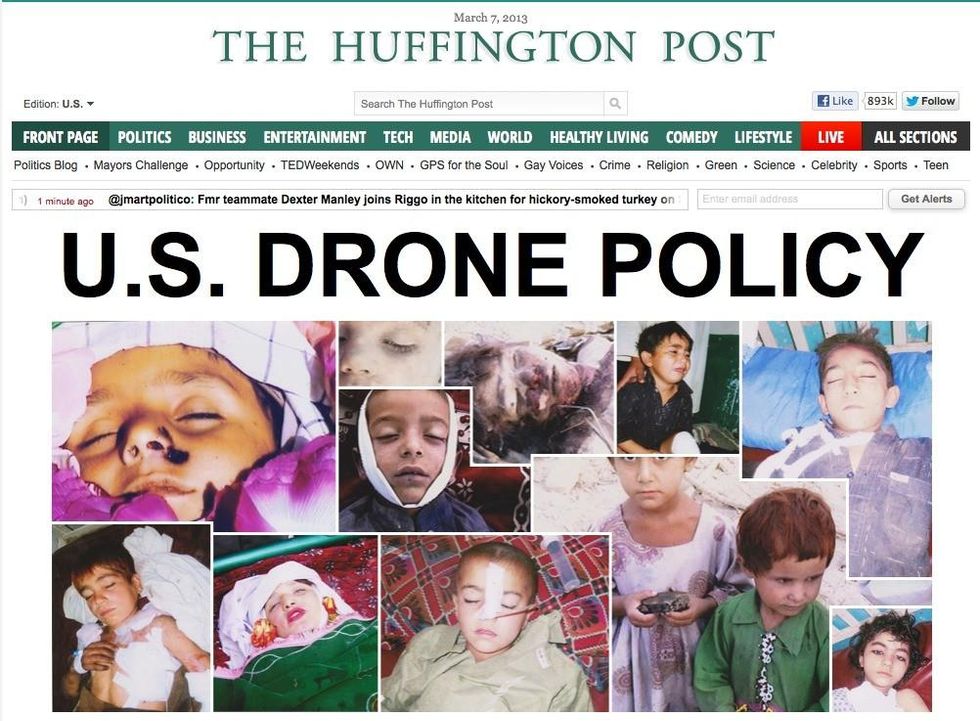HuffPo Makes Deadly Reality of US Drone Policy Painfully Clear
With dramatic images of dead Afghan children, often cautious website puts ongoing US drones front and center
In an editorial decision clearly designed to provoke emotion and bring attention to the often ignored death toll of innocent people--especially children--killed by missiles from US drones in recent years, the Huffington Post on Thursday used its masthead to show grim pictures of dead or wounded child victims of a program widely defended by the president, politicians from both parties, and the military.

As Grim and Hersh report:
Civilian casualties are central to the debate over the use of drones, because public support hinges on the false belief that the weapons kill with surgical precision. If the public were aware of the human toll of the policy, opposition would be widespread, according to a series of HuffPost/YouGov surveys.
Noor Behram, a Pakistani photojournalist who lives in North Waziristan, has been documenting the human cost of U.S. drone policy for several years and said he "wants people to know" what the weapons have wrought. The photographer provided photos to documentary filmmaker Robert Greenwald, in Pakistan doing research and interviews for his forthcoming documentary, "UNMANNED: America's Drone Wars," in fall 2012. Some of Behram's photos are used to illustrate this article.
Some Behram kept to himself, thinking they are "so horrific he didn't want anyone to see them," Greenwald told HuffPost. "So we're seeing the ones he felt were painful, but not so stomach-turning it'd be impossible to look at them."
The names of many of the child victims of drones were collected in an investigation by The Bureau of Investigative Journalism and the images collected by Behram were collated into this short video by Brave New Films (warning: many of the images are graphic and disturbing):
What seems clear, however, is that the Huffington Post decision to lead with this story in the manner they did is both a break from their sometimes tabloid coverage of popular culture and also a commendable attempt to bring the human costs of US foreign policy to the attention of its readerhsip, one of the largest on the web.
Read the full report here.
Review Common Dreams' ongoing coverage of US drone policy and its victims here.
_________________________________________
An Urgent Message From Our Co-Founder
Dear Common Dreams reader, The U.S. is on a fast track to authoritarianism like nothing I've ever seen. Meanwhile, corporate news outlets are utterly capitulating to Trump, twisting their coverage to avoid drawing his ire while lining up to stuff cash in his pockets. That's why I believe that Common Dreams is doing the best and most consequential reporting that we've ever done. Our small but mighty team is a progressive reporting powerhouse, covering the news every day that the corporate media never will. Our mission has always been simple: To inform. To inspire. And to ignite change for the common good. Now here's the key piece that I want all our readers to understand: None of this would be possible without your financial support. That's not just some fundraising cliche. It's the absolute and literal truth. We don't accept corporate advertising and never will. We don't have a paywall because we don't think people should be blocked from critical news based on their ability to pay. Everything we do is funded by the donations of readers like you. Will you donate now to help power the nonprofit, independent reporting of Common Dreams? Thank you for being a vital member of our community. Together, we can keep independent journalism alive when it’s needed most. - Craig Brown, Co-founder |
In an editorial decision clearly designed to provoke emotion and bring attention to the often ignored death toll of innocent people--especially children--killed by missiles from US drones in recent years, the Huffington Post on Thursday used its masthead to show grim pictures of dead or wounded child victims of a program widely defended by the president, politicians from both parties, and the military.

As Grim and Hersh report:
Civilian casualties are central to the debate over the use of drones, because public support hinges on the false belief that the weapons kill with surgical precision. If the public were aware of the human toll of the policy, opposition would be widespread, according to a series of HuffPost/YouGov surveys.
Noor Behram, a Pakistani photojournalist who lives in North Waziristan, has been documenting the human cost of U.S. drone policy for several years and said he "wants people to know" what the weapons have wrought. The photographer provided photos to documentary filmmaker Robert Greenwald, in Pakistan doing research and interviews for his forthcoming documentary, "UNMANNED: America's Drone Wars," in fall 2012. Some of Behram's photos are used to illustrate this article.
Some Behram kept to himself, thinking they are "so horrific he didn't want anyone to see them," Greenwald told HuffPost. "So we're seeing the ones he felt were painful, but not so stomach-turning it'd be impossible to look at them."
The names of many of the child victims of drones were collected in an investigation by The Bureau of Investigative Journalism and the images collected by Behram were collated into this short video by Brave New Films (warning: many of the images are graphic and disturbing):
What seems clear, however, is that the Huffington Post decision to lead with this story in the manner they did is both a break from their sometimes tabloid coverage of popular culture and also a commendable attempt to bring the human costs of US foreign policy to the attention of its readerhsip, one of the largest on the web.
Read the full report here.
Review Common Dreams' ongoing coverage of US drone policy and its victims here.
_________________________________________
In an editorial decision clearly designed to provoke emotion and bring attention to the often ignored death toll of innocent people--especially children--killed by missiles from US drones in recent years, the Huffington Post on Thursday used its masthead to show grim pictures of dead or wounded child victims of a program widely defended by the president, politicians from both parties, and the military.

As Grim and Hersh report:
Civilian casualties are central to the debate over the use of drones, because public support hinges on the false belief that the weapons kill with surgical precision. If the public were aware of the human toll of the policy, opposition would be widespread, according to a series of HuffPost/YouGov surveys.
Noor Behram, a Pakistani photojournalist who lives in North Waziristan, has been documenting the human cost of U.S. drone policy for several years and said he "wants people to know" what the weapons have wrought. The photographer provided photos to documentary filmmaker Robert Greenwald, in Pakistan doing research and interviews for his forthcoming documentary, "UNMANNED: America's Drone Wars," in fall 2012. Some of Behram's photos are used to illustrate this article.
Some Behram kept to himself, thinking they are "so horrific he didn't want anyone to see them," Greenwald told HuffPost. "So we're seeing the ones he felt were painful, but not so stomach-turning it'd be impossible to look at them."
The names of many of the child victims of drones were collected in an investigation by The Bureau of Investigative Journalism and the images collected by Behram were collated into this short video by Brave New Films (warning: many of the images are graphic and disturbing):
What seems clear, however, is that the Huffington Post decision to lead with this story in the manner they did is both a break from their sometimes tabloid coverage of popular culture and also a commendable attempt to bring the human costs of US foreign policy to the attention of its readerhsip, one of the largest on the web.
Read the full report here.
Review Common Dreams' ongoing coverage of US drone policy and its victims here.
_________________________________________

